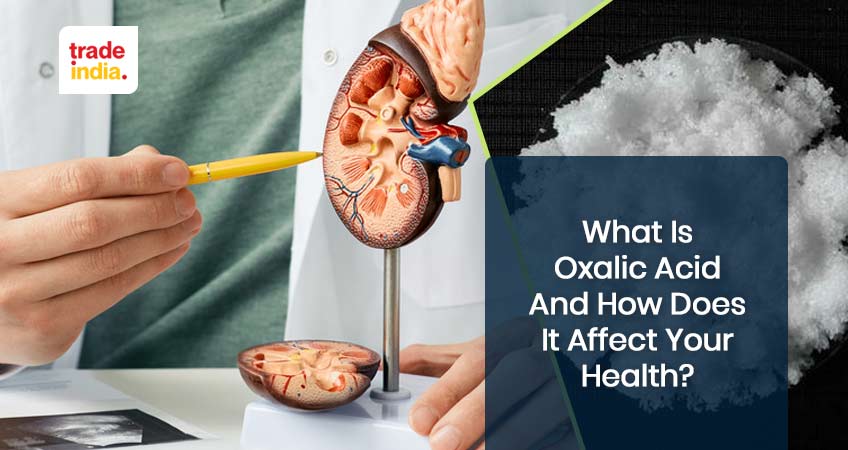What is Oxalic Acid and How Does it Affect your Health?

Introduction
Oxalic acid is a carboxylic acid that is colorless, crystalline, and highly poisonous. Another name for it is ethanedioic acid. Because it can convert most insoluble iron compounds into a soluble complex ion, oxalic acid is commonly employed as an acid rinse in laundries for the purpose of eliminating rust and ink stains. It is also the main ingredient in several commercial radiator scale removers for the same reason.
The crystalline hydrate, (COOH)22H2O, is the most common form of oxalic acid, which has the formula (C2H2O4). Although oxalic acid was first synthesized in 1776, it had been identified as a component of wood sorrel as early as the 17th century.
It can be produced by oxidizing carbohydrates with nitric acid, heating sawdust with caustic alkalies, fermenting sugar solutions with specific molds, or heating sodium formate in the presence of an alkali catalyst.
What is oxalic acid and how does it affect your health?
Subsequently, the body expels the substances through waste products including feces and urine. Diets high in oxalates can lead to kidney stones in those who are especially sensitive to them. Another health issue for which their risk is increased is obesity.
1. Antibiotic Interactions
Oxalates prevent other substances from entering the urinary system when they degrade in the digestive tract. Antibiotics have been shown to mitigate this consequence. Improvements in gut function are attributed to their ability to reduce beneficial microorganisms that aid in oxalate absorption.
2. Reduced Mineral Absorption
Because of the binding of oxalic acid formula to other minerals in the digestive tract, absorption of these minerals is hindered. Calcium and oxalate are both abundant in spinach. Calcium from spinach cannot be absorbed by the body, while calcium from other foods, like milk, can. Fibrous foods may further hinder the body's ability to absorb vital nutrients.
Oxalates are often referred to as "anti-nutrients" by the general public. This is due to the fact that they bind to particular minerals and so inhibit the body from absorbing and making use of those minerals.
Spinach is a great illustration of this. In spite of the fact that it is abundant in the vital elements calcium and magnesium, it also has a high oxalate content. It is possible that the oxalate will prevent these minerals from being absorbed since it will combine with them to produce a complex.
3. Kidney Stone Formation
Calcium and trace levels of oxalate in the urine both occur normally. Individually, they pose no danger to health. They can combine and create crystals when dissolved.
Some people are more prone to developing these stones than others, particularly if their oxalate levels are high and their urine output is poor.
Due to their diminutive size, they may go unnoticed. The issue arises when these smaller stones coalesce into larger ones. As the stones pass through the urinary tract, they cause nausea, intense discomfort, and blood in the urine.
The majority of kidney stones are composed of calcium oxalate. Because of this, if you suffer from kidney stones, your doctor may recommend avoiding oxalate-rich meals. Studies have shown that it may not be realistic to avoid foods high in oxalates anymore.
People who have high levels of oxalate in their urine are often advised to follow a strict low-oxalate diet of fewer than 50 milligrams per day.
4. Reduces the Affection of Cystic Fibrosis
This is an inherited digestive illness and lung that causes the body to create thick and sticky mucus. The accumulation of this mucus may lead to obstructions in the lungs and the pancreas.
Even though cystic fibrosis cannot be cured and cannot be avoided, the risk of developing complications can be mitigated.
Patients diagnosed with cystic fibrosis should constantly follow their doctor's advice and consume foods that are low in oxalic acid structure in order to prevent future issues known as hyperoxaluria.
According to the findings of the study, people with cystic fibrosis had a rate of hyperoxaluria that was 51%. Hyperoxaluria is a dangerous risk factor for kidney stones.
5. Prevents Underactive Thyroid Problems
When there is an excess of oxalate in the body, it will store in the thyroid as well as the various tissues. The production of crystals in the thyroid is caused by an excessive amount of oxalate because it binds to T3, a hormone that is secreted by the thyroid.
This crystal lowers the amount of activity produced by the thyroid gland, which in turn causes a variety of symptoms, including weight gain, weariness, an increase in cholesterol level, difficulties with menstruation, and so on.
As a result, it is usually preferable to keep one's consumption of foods that contain oxalate to a minimum.
Also Read: Top 10 Acid Slurry Manufacturers, Suppliers & Exporters in India
6. Effective for Autism Patients
Researchers have hypothesized that those who have autism may have a genetic predisposition to being intolerant of oxalates.
Individuals with autistic tendencies have reported an improvement in their symptoms when they consume a diet low in oxalic acid uses, despite the fact that the metabolic processes involved are not fully understood.
Your Gut and Oxalate Absorption
The process of breaking down oxalates is not always successful for individuals who have low quantities of this bacterium in their digestive tracts. Antibiotics are used to combat the bacterial colonies found in the digestive tract.
Okay, here are some tricks to follow a low oxalic diet:
1. Enjoy Low Oxalate Foods
Oxalate levels can be lowered by eating a diet low in certain foods. Avocados, herbal tea, dairy products, cauliflower, chicken, and pork are all acceptable on a reduced oxalate diet.
2. Consume Calcium Rick Foods
The production of kidney stones is inhibited when oxalate and calcium form a stable complex. So, if you're on an oxalate diet, you should supplement your meals with dairy products strong in calcium, such as yogurt and cheese.
3. Drink Plenty of Water
Water aids the kidneys in eliminating waste products and decreasing the risk of kidney stone formation. Aim for eight 8-ounce glasses of water or other fluids daily.
4. Avoid Excessive Sodium in Diet
Hydration helps the body flush out oxalate, but sodium makes the body hold on to water, thus it doesn't work.
5. Cut Down Excess Vitamin C Supplementation
Vitamin C, when digested, converts to the mass of oxalic acid in the body. Intense vitamin C supplementation has been linked to oxalate accumulation, which in turn has been linked to a host of health problems.
If you have inflammatory bowel illness, you also have a greater likelihood of acquiring kidney stones, according to the findings of several studies. This is due to the fact that your body is unable to regulate the number of oxalates that it takes in.
Conclusion
Low-oxalate diets can help those who have a high risk of kidney stone production due to high oxalate levels in their bodies. This category includes cauliflower, cheese, and bone-in tuna and salmon. They are a good source of calcium as well. Vegetables high in oxalate should be boiled and adequate calcium and water intake should be maintained. Greens like spinach, chard, and kale contain oxalate which causes problems for some people.
Complexes formed by oxalate in the digestive tract can prevent the absorption of calcium and other minerals. Some people may also get kidney stones if they consume too much oxalate. Some patients may be instructed by their doctors to follow a low-oxalate diet.
FAQs: Oxalic Acid
Q. What foods contain a lot of oxalic acids?
Ans. Sweet Potatoes, Fruits, Coca, Nuts, Star Fruit, Seeds, Leafy Green Vegetables, Spinach, Almonds, Rich brand, Miso, and Rhubarb are some foods that contain a lot of oxalic acids.
Q. Is oxalic acid effective at removing rust?
Ans. Yes, walkways, buildings, boats, concrete roads, iron machinery, swimming pools, wood decks, staircases, and trim can all benefit from a cleaning using oxalic acid to remove rust and other stubborn stains.
Q. How is oxalic acid used in the toilet?
Ans. Thickened oxalic acid results in a cleaner that is effective for removing rust from metal, cleaning toilet bowls, and cleaning vertical surfaces.
Q. How does one create oxalic acid at home?
Ans. Follow the steps:
- Get some distilled water and clean and dry a watch glass.
- Get a scale, clean and dry some watch glass, and record the weight of that amount.
- 3.15 grams of oxalic acid should be accurately measured using a watch glass and recorded in the lab notebook.
- Slowly and carefully transfer the oxalic acid from the watch glass to the dry volumetric cylinder.
- With the use of a wash bottle, remove any debris from the watch glass by washing it with distilled water to let the particles clinging to the glass dissolve into the foam.
- The maximum amount of distilled water that should be used for this purpose is 50 ml.
- Any debris caught in a funnel can be easily removed by rinsing it several times with distilled water before being poured into a 100ml beaker.
- Slowly add a small amount of water while washing the funnel. As little as 50 mL of distilled water is all that's needed for this.
- Carefully rinse the funnel with distilled water from a wash bottle before using it to transfer the solution from the vial to the measuring flask.
- Spinning the measuring flask will help the oxalic acid dissolve.
Related Blog Topics:
- Importance of Calcium Chloride in Chemical Business
- Sodium Carbonate Market Size, Share, Trends & Growth Opportunity in India
- An Overview of Ammonium Chloride Market Size, Share & Scope
